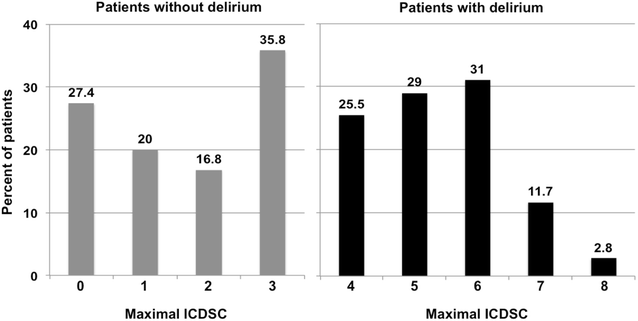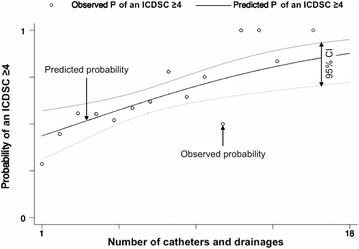Risk factors for new-onset delirium in patients with bloodstream infections: independent and quantitative effect of catheters and drainages-a four-year cohort study
- PMID: 27797086
- PMCID: PMC5085969
- DOI: 10.1186/s13613-016-0205-x
Risk factors for new-onset delirium in patients with bloodstream infections: independent and quantitative effect of catheters and drainages-a four-year cohort study
Abstract
Background: Bloodstream infections (BSI) and delirium are frequent in critically ill patients. During systemic inflammatory response to BSI, cytokines may interact with neurotransmitters and neuronal receptors driving acute brain dysfunction. However, prospectively collected data on incidence, prediction and impact of delirium in association with BSI are lacking. This study aimed to determine the incidence and predictors of new-onset delirium and its impact on outcome in critically ill adult patients with BSI.
Methods: From 2011 to 2014, all consecutive adult patients with BSI treated in the intensive care units of an academic medical care center were identified. Pertinent clinical and microbiological data including the Intensive Care Delirium Screening Checklist (ICDSC) were assessed. Multivariable analysis was performed to identify variables independently associated with ICDSC ≥4.
Results: Among 240 patients, 145 (60%) had an ICDSC ≥4 (i.e., delirium). In-hospital mortality was 34%. Delirious patients had a higher mortality (40 vs. 23%; p = 0.005), a lower proportion with return to functional baseline (30 vs. 46%; p = 0.012), and a higher proportion with unfavorable outcome in survivors (74 vs. 54%; p = 0.010). Multivariable analyses revealed age (OR 1.04, 95% CI 1.02-1.06), male gender (OR 2.26, 95% CI 1.17-4.36), and the number of catheters and drainages before diagnosis of BSI (OR for every additional catheter = 1.14, 95% CI 1.04-1.25) as independent predictors for delirium (adjusted for SAPS [simplified acute physiology score] II, Riker Sedation-Agitation Scale [SAS], Sequential Organ Failure Assessment [SOFA] score, dementia and/or leukoencephalopathy, and albumin levels).
Conclusions: The incidence of delirium in patients with BSI is high and associated with adverse outcome. The number of catheters and drainages may constitute a useful and readily available predictor of delirium in patients with BSI allowing to identify patients at high risk. Ultimately, reliable identification of patients at increased risk for delirium is key for allocation of specific prevention strategies.
Keywords: Bloodstream infections; Catheters; Delirium; Drainages; Risk factors.
Figures


References
LinkOut - more resources
Full Text Sources
Other Literature Sources

